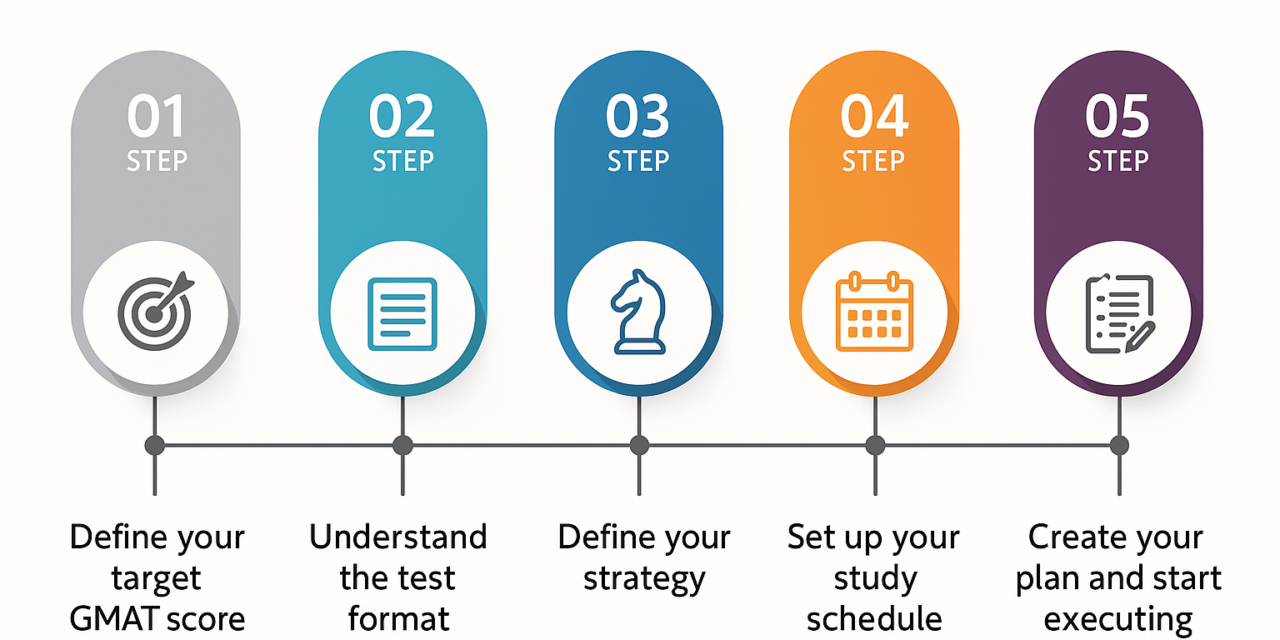Are you aiming to score 655+ on the GMAT within a month and are looking for a plan that will help you achieve your dream score? Well, you have come to the right place! In this article, we shall look at how you can clear the first hurdle toward your MBA dreams with flying colours.
Before you dive into how you can create your one-month study plan for GMAT, watch this video where we highlight how a personalized study plan can save you up to 60+ hours of GMAT preparation time.
Start GMAT Focus Prep Now
Take a quick quiz and get personalized feedback to jumpstart your prep. Ready to ace the GMAT in 30 days?
How to prepare for the GMAT in 1 month?
When time is limited, efficient planning and execution become critical to success. Having a precise plan and a focused approach ensures that you make the most of your time and do not spend any time on non-productive activities. This is exactly what our article is all about. It will help you understand how you can prepare for GMAT in the limited time available efficiently. Find out how?
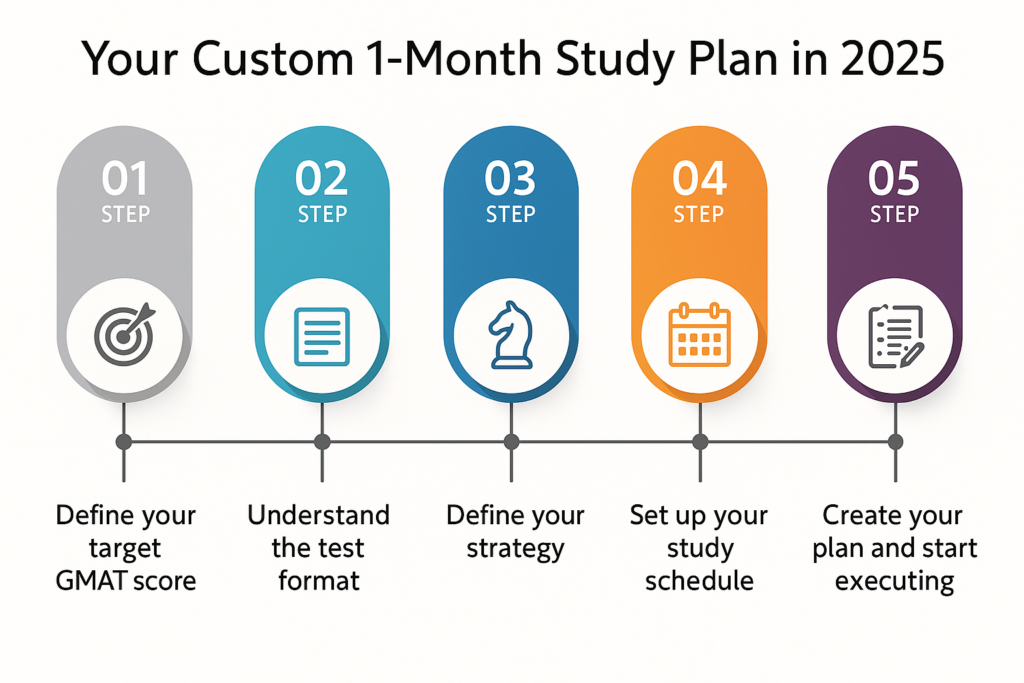
Can I study for GMAT in 1 month?
Yes, it is possible to achieve your target score in less than 30 days if you follow the right strategy. By setting a realistic goal and putting in a good number of hours into study, you can achieve your target score. Here are a few examples of the students who improved their score in less than 30 days by working hard and following the right strategies.
- Sankha improved from 85%ile to 99%ile and achieved a 715 by following the e-GMAT’s 30-day hyper specific improvement plan. Learn how.
- Divyam improved from a 645 to 735 (Q90 DI89 V85) in 15 days. He focused on “logical approach” and building “core skills”. Click here to watch his amazing video interview.
- Nikhar improved from 555 to 675 in just 30 days. Learn how he achieved this amazing feat.
- Sayam improved from 675 to 745 (100 Percentile) in just 30 days. Watch his video interview to learn how he achieved this feat.
However, if you do not follow your study plan correctly or give less time than required, you might not be able to reach your target score. For instance, if a student is looking for a 200-point improvement within 30 days and puts in only 2 hours of preparation time daily, cracking the GMAT would be a daunting task.
Begin your GMAT preparation with the only GMAT prep company that has delivered more 645+ scores than any other GMAT Club partner. Take our free trial today and discover how we can help you achieve your GMAT goals in just one month.
What should be the strategy to ace GMAT within 1 month?
At e-GMAT, we follow three stages of learning methodology that has helped thousands of students achieve their target GMAT score
Stage 1 is where you learn the concepts. First, you go through all the files of all the modules. The files are sequenced in order as they follow the logic of –
i) Learning the concept through concept files,
ii) Testing the understanding of concept through concept practice quizzes,
iii) Practicing application of these concepts through application files
iv) Practice quizzes to practice and evaluate your learnings
If you deviated from the recommended sequence of learning, then it could result in a gap in your learning. Thus, you will have to revisit the files again and again. In order to avoid this, please follow the sequencing of files and do not skip files.
Secondly, you should score at least 80% in practice and concept quizzes available in our course to move to Stage 2.
To assist you further in every sub-section, an Error Log template is provided by us, which helps you to identify your gaps in concepts and processes, so that you can work on them accordingly.
Stage 2 Cementing is where you cement the concepts and master the applications you have learnt in Stage 1. It is one of the most important parts of your preparation that will help you get to your target score by helping you master the applications that get tested in GMAT. Do not skip cementing right after Stage 1.
The cementing process has been explained in the last module of every sub-section in the course for ease.
Stage 3 Test readiness is one of the most crucial stages, this is where you work on your test-taking skills and mindset. This is the stage where you start solving mixed quizzes which involve questions from multiple sub-sections, which in turn helps build your stamina and transitions skills.
Lastly, if you are facing any issue with your preparation, you can directly connect with our strategy experts on email at support@e-gmat.com.
If you follow all these stages diligently, you have very high chances of reaching your target score.
Get Your Personalized 30-Day GMAT Study Resources
Reaching your target score in 30 days is not an impossible task. You need to have a foolproof, time-tested strategy and the best resources. Let’s find out:
Study GMAT in one month (Sample plan)
Below is the plan for our student who was at 655 level and reached GMAT 715 in a month. He gave 8 hours/ day on weekends and 3 hours/ day on weekdays for 4 weeks. This is just a sample plan, and we recommend that you get your starting levels before proceeding.
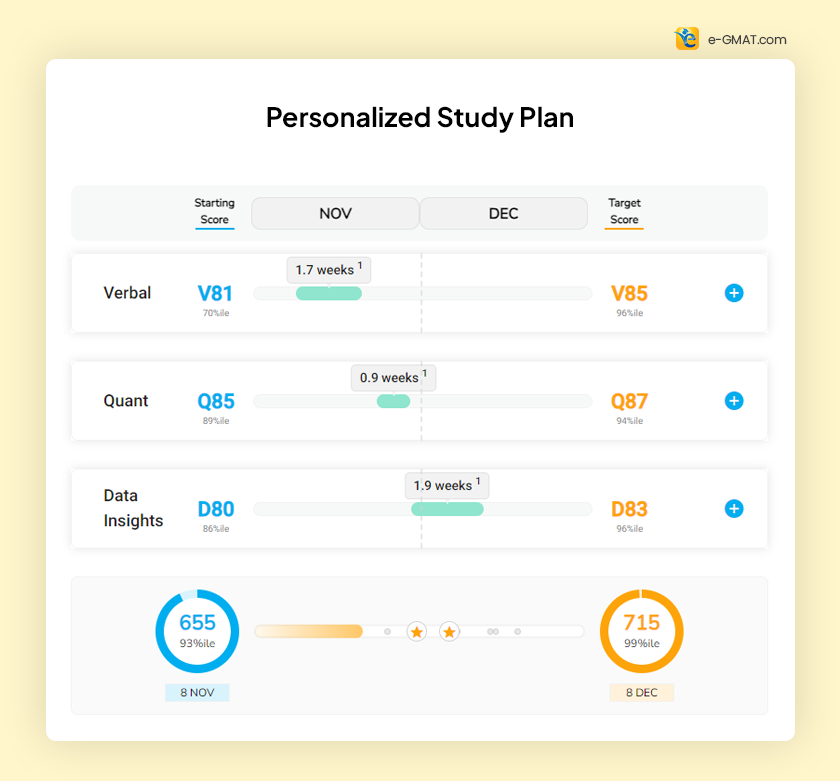
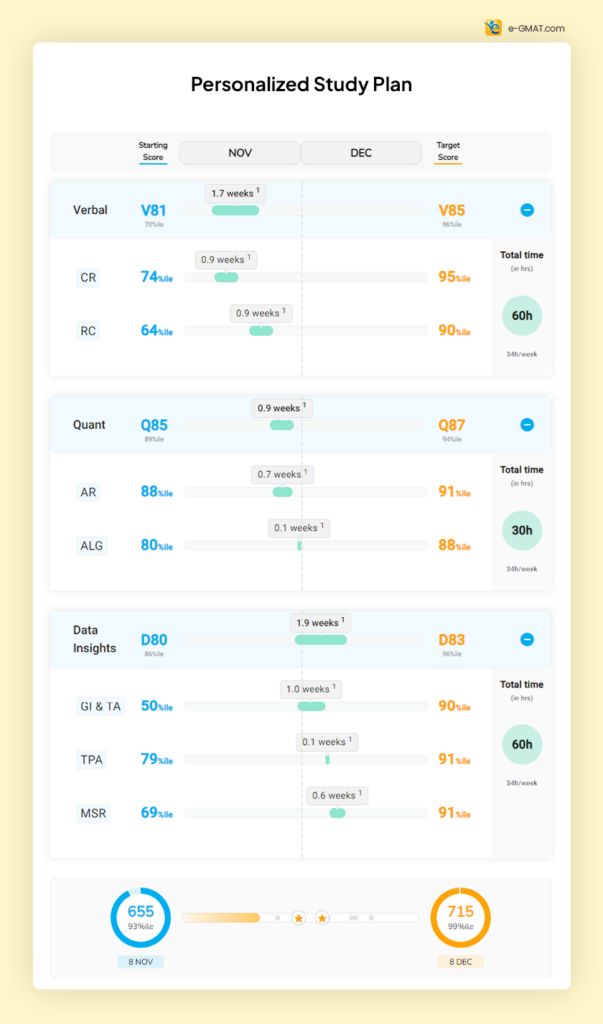
Write to us at acethegmat@e-gmat.com if you need help in crafting your study plan. Our team of GMAT Strategy Consultants would love to help you!
Detailed version of Milestones | GMAT 1 month study plan
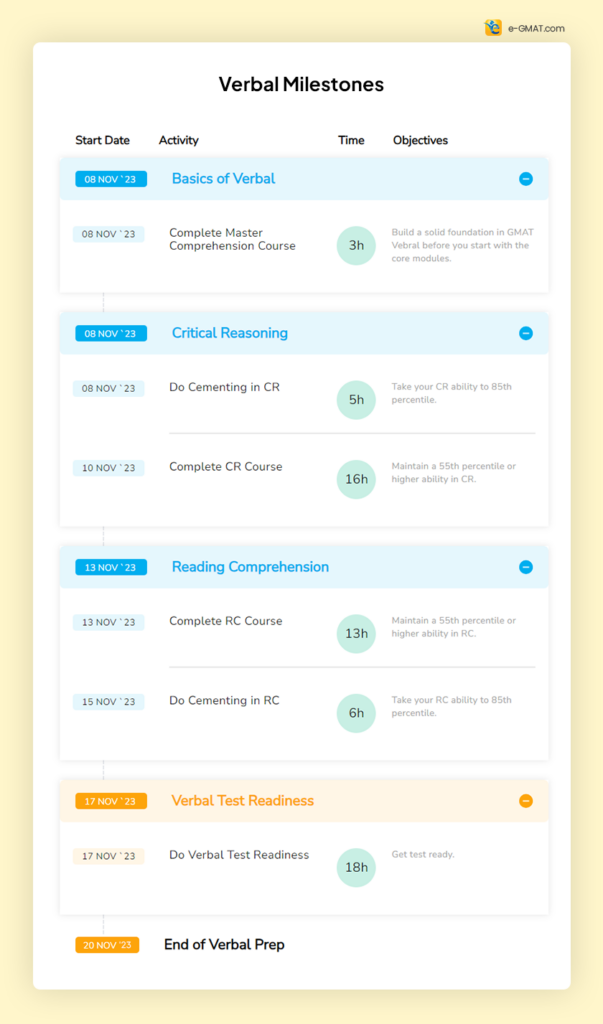
How to make 1-month study plan for GMAT?
In order to create your one-month study plan for the GMAT, here are 5 steps to create your GMAT study plan to ace the GMAT in less than 30 days:
- Define your target GMAT score
- Understand the test format
- Define your strategy
- Set up your study schedule
- Create your plan and start executing
1. Define your Target GMAT Score
Do you have a clear target score in mind or are you just testing the waters and hoping for a ‘good score’ in GMAT? The shortest answer to this is whatever score gets you in your target program with scholarships if you are aiming for one. Your target score should, therefore, be the median GMAT score required for your target program. If, however, you are looking to get a Scholarship/Fellowship, you must aim for 30 points over the median score. This would make your profile competitive with other students vying for Scholarships.
If you are confused about how the new GMAT scoring works, refer to this article:- GMAT Focus Score & Percentile.
Learn what is a good GMAT score for earning MBA scholarships in this article.
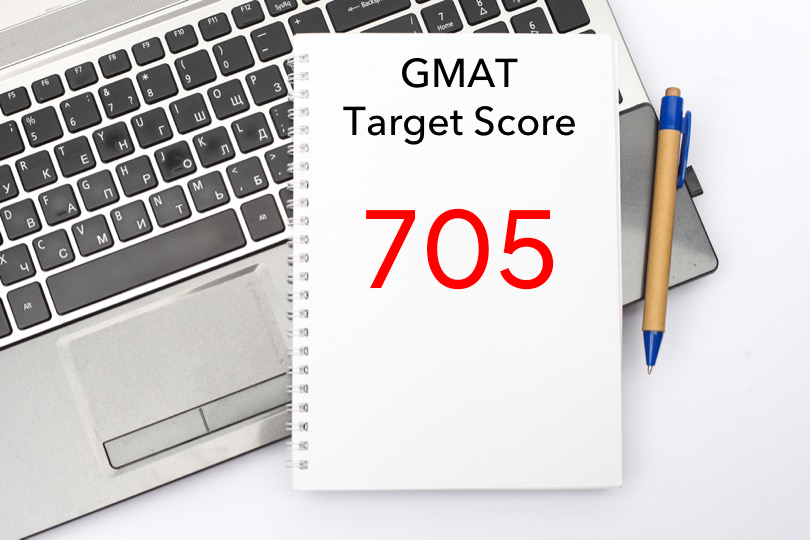
Confused about what target GMAT score you should aim for? Follow this 5-step process in this article to determine the answer.
2. Acquaint yourself with the test format
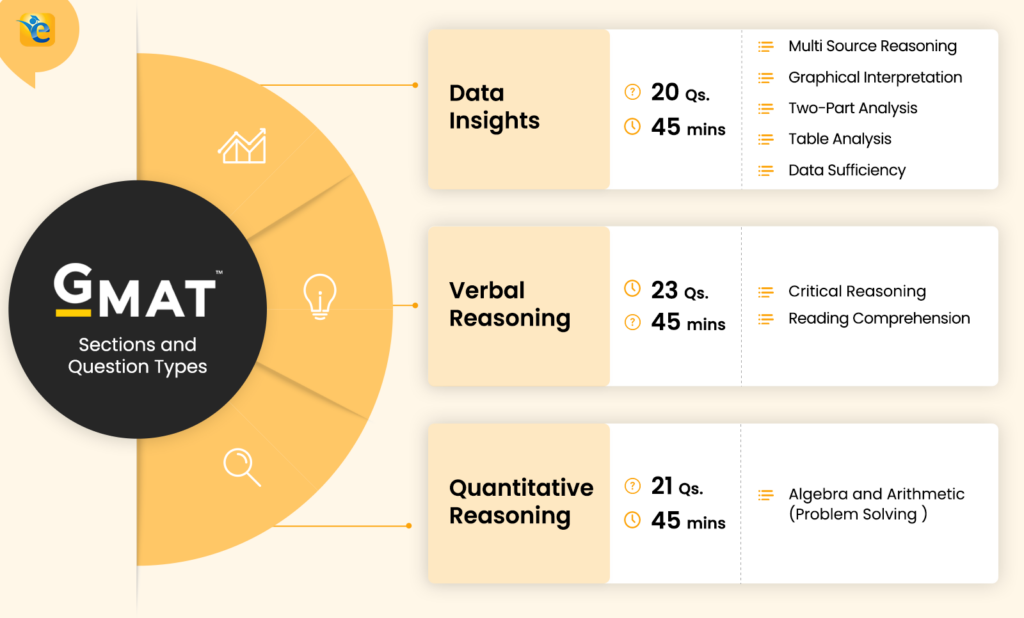
Once you have found out the target score that you must aim for, the next step would be to familiarise yourself with the test format. Understanding the test format will ensure that you won’t be surprised on the test day. For your quick reference, I have shared links to two articles that will help you acquaint yourself with the test format.
- GMAT Exam Format – This article answers all your questions about the updated GMAT Exam Format and Timing, Exam Structure, Sections, and Question Types.
- GMAT Eligibility Criteria – This article is your guide to all that you need to know about GMAT eligibility criteria and the registration process.
At e-GMAT, we strive to make the students’ life easier at every level and therefore, we have built this fantastic tool called the GMAT Personalized Study Planner. With this tool, you can not only find out the Verbal, Quant and DI Sectional scores but also Sub-sectional scores in Verbal (CR and RC), Quant (Algebra, Arithmetic, etc.) and DI (GI&TA, TPA, MSR and DS) to achieve your target GMAT Score! Try it for Free!!
3. Define your strategy
After you have a target score in mind, you should give a diagnostic test that will help you know your current/starting abilities. Also, the diagnostic test score will tell you about the Stage you should start from. According to e-GMAT if you are below Q80 (64th percentile) and V80 (56th percentile) level in any sub-section, then you need to start from Stage 1. You can also take the diagnostic test that we offer in our Free Trial.
Once you take the Diagnostic test, you can refer to the below table to see the amount of time you would require improving to your target score. However, on average, students require about 7 hours of preparation with a data-driven online course for every 10 points improvement.
| TIME | SCORE IMPROVEMENT |
| 50 Hours | ~ 55 – 70 points Improvement |
| 70 Hours | ~ 70 – 100 points Improvement |
| 90 Hours | ~ 100 – 130 points Improvement |
| 100 Hours | ~ 120 – 140 points Improvement |

If you are a full-time working professional and wondering how to make time for preparation, we recommend that you read our article on Study Plan for Working Professionals – Balancing Work and Study.
So, if your current level is of scoring 565 on the GMAT and you spend about 90 hours in preparation, then you would improve to scores of around 665 – 675. So, if you know that the difference between your target score and your current score is 80 points, then you can determine from the table that you would need to study for approximately 70 hours.
Based on your diagnostic scores, you must define whether your strategy should be Verbal-driven, Quant-driven or DI-driven. If through your diagnostic score, you realize that your relative strength is Verbal, then you must leverage this strength by targeting a higher score in it and then planning the required score in Quant and DI.
For example – you score 565 in your diagnostic test with the break-up of V82 (74th percentile), Q75 (32nd percentile) and DI77 (62nd percentile). This clearly indicates that your relative strength out of the three sections is Verbal followed by DI. If you are aiming for a score of 675, then you should aim for V85 (94th percentile), Q84 (85th percentile) and DI81 (89th percentile).
Post this, you can create a Personalized study plan. To help you effectively plan for the GMAT, we have created an amazing tool called the Personalized Study Planner (PSP) tool. Create your own milestone driven GMAT study plan in 5 minutes.
Here are the features of this GMAT study plan tool and here is the link to the PSP tool itself.

PSP tool is designed in such a way that you can adjust your GMAT test date according to the number of hours you put it for preparation. Once you have made your study plan, you can schedule your days accordingly. The plan will let you know about number of days and number of hours required for each sub-section.
4. Set up a Study Schedule

Before you sit down to study, plan your study schedule for the entire month. One of the best practices for this is to block the time in your calendar for GMAT study, so that you do not schedule any other activity at that time. Discipline is critical to ensure that you put in the required effort towards your GMAT Prep. Your daily plan should include the amount of time you would be spending each day along with the time of the day you would do it.
- Sayam scored a 745 (100 percentile) on GMAT Focus. He made sure that he planned his time in advance and block his calendar accordingly. Click here to know how he managed to get to a 100th percentile in GMAT focus despite a full-time job.
5. Start with a section which is your strength
We recommend that you begin with the section that is your strength as it will set a good momentum for your preparation. Since you are already better at it, it would be easier for you to improve, and you would not have to go through everything in that section. You must do a topic level analysis of your preparedness and prepare only those topics in which you are not up to the mark. In our advanced quizzing platform, Scholaranium, you can take Cementing Quizzes which helps you to do just that. We recommend that you follow the below-mentioned steps:
- Take Cementing Quiz for the relevant section
- Go to the Skill Data section and Isolate the topics in which you are weak and improve upon them
- Track your improvement and repeat the process until you reach desired scores.
Now coming to the section in which you are relatively weaker, you must spend more time on this section as the improvement that you seek is more. You must make sure that you understand the concepts and the process to solve GMAT like questions of this section. You must work on this section until you reach your desired score, instead of completing the entire section thoroughly, since you have limited time.
Begin your GMAT preparation with the only prep company that has delivered more 700+ scores (645+ scores) than any other GMAT club partner. Achieve GMAT 695+ with our AI driven tools that you personalized feedback at every step of your GMAT journey. Take our free trial today!
Best Practices while studying for GMAT
To make sure that you do not spend time unnecessarily, we have compiled a list of best practices to make the most of your time.
- If you are an e-GMAT student, you can skip the lesson in which you score 100% on the pre-assessment quiz. This will save you time that you can utilize later in fine-tuning.
- At e-GMAT, we believe in timely feedback and hence, you will get regular feedback on your learning. If you score less than 80% in any file, you must ensure that you re-work on the file till you are able to get 80% or more before moving on. Tackling the topic right then and there will ensure that the learning is cemented in lesser time.
- After completing each section, take Cementing Quiz in Scholaranium and ensure you have reached your target ability in that section. If not, you must identify the topics in which you are weak and improve upon it before moving on to the next section.
- Make comprehensive notes that you can refer to later while revising. e-GMAT students can make notes in the course itself to later revisit them, from the Notes tab.
- Maintain an error log so that you can review the mistakes you have made in the past and ensure that you do not repeat them. You can bookmark the question within the course itself and access it from the Bookmarks tab.
- Take mock tests after the learning phase is over and make sure you review each test well and improve upon the weak areas before taking the next test. Only taking mock tests without revising would not help.
- We do not recommend taking a mock test in the 3 days before your GMAT. In the last 3 days, you must revise your notes, go through your error log, study for IR and AWA to make sure you are not burned out on the test day!
Conclusion
To summarize, you must spend a couple of hours before jumping right into your course material to create a well-defined plan to ace the GMAT. Once you have created the plan you must make sure that it covers the following points:
- Study Schedule
- Amount of time to be devoted daily
- Buffer time in case of backlog
- Resources to use at different stages of prep:
- Resources to be used for learning
- Resources to be used for tracking progress/feedback
- Mock Tests
- Resources to be used for other exams related information
- Plan to utilize the resources in a limited time
When you study with a singular focus of acing the test, reaching your target score is just a matter of time.
All the best!
At e-GMAT, we strive to make the students’ life easier at every level and therefore, we have built this fantastic tool called the GMAT Personalized Study Planner. With this tool, you can not only find out the Verbal, Quant and DI Sectional scores but also Sub-sectional scores in Verbal (CR and RC), Quant (Algebra, Arithmetic, etc.) and DI (GI & TA, TPA, MSR and DS) to achieve your target GMAT Score! Register for our FREE Trial and create your personalized study plan in 5 mins!


